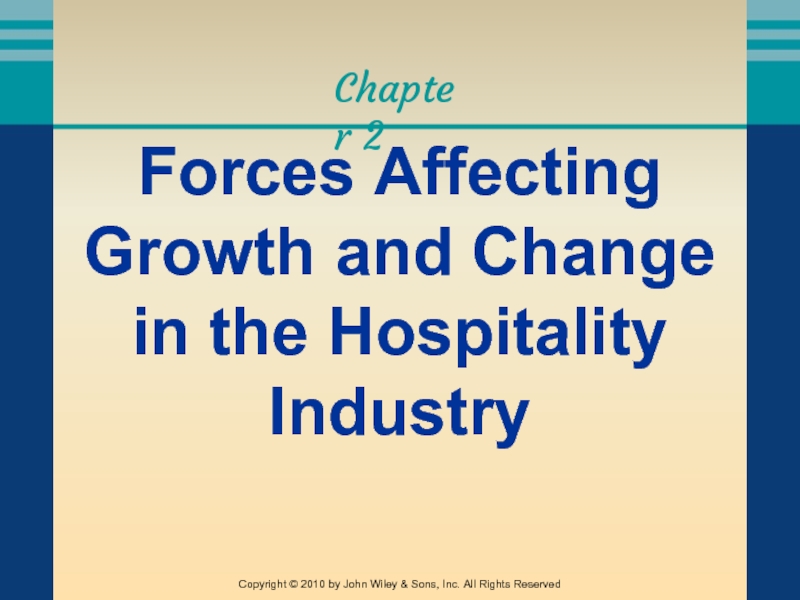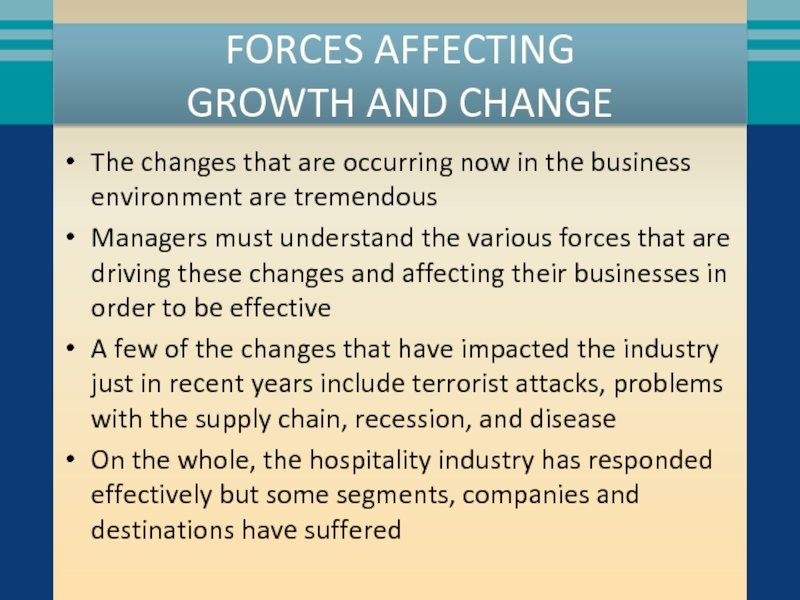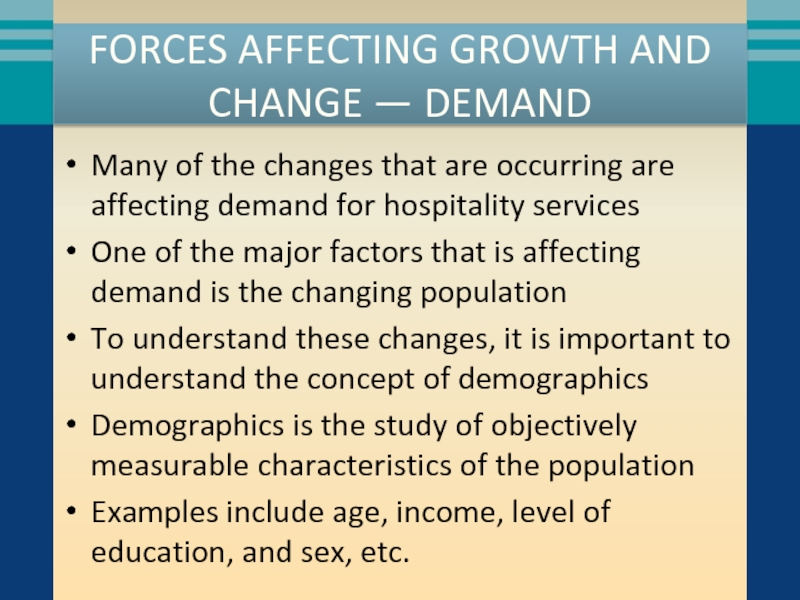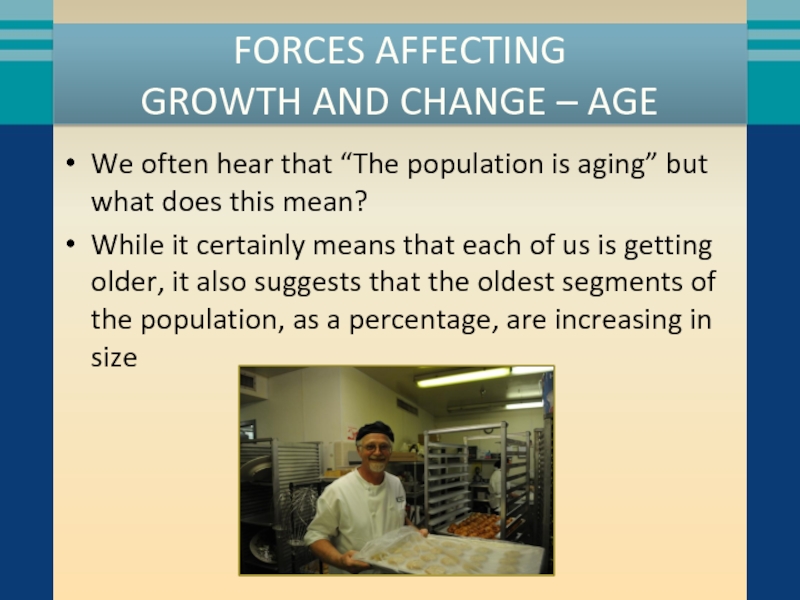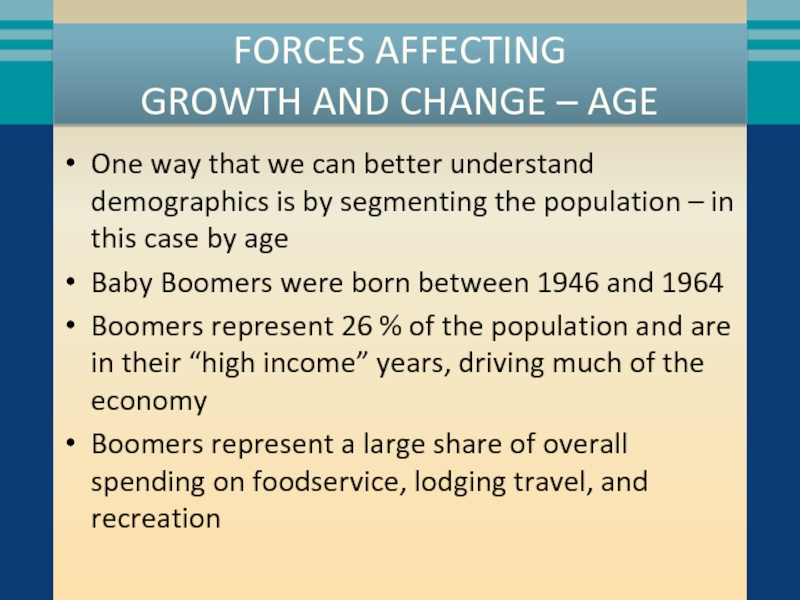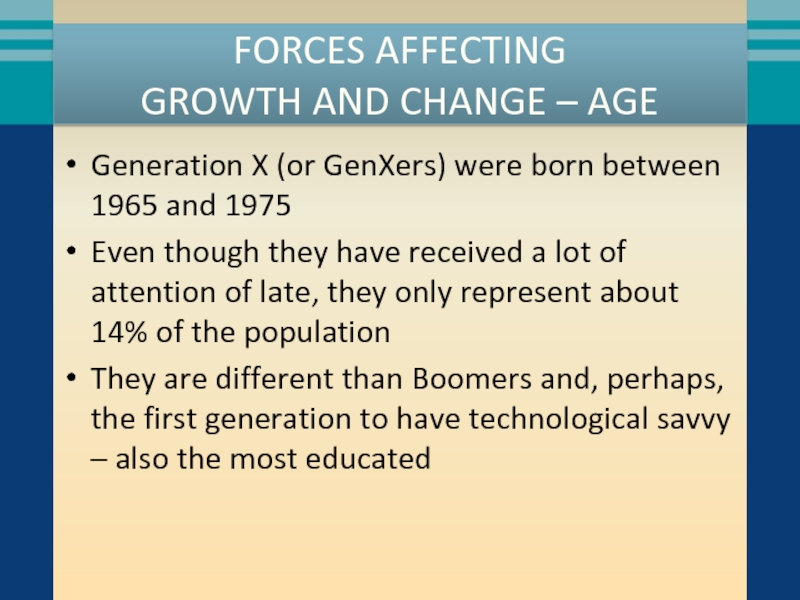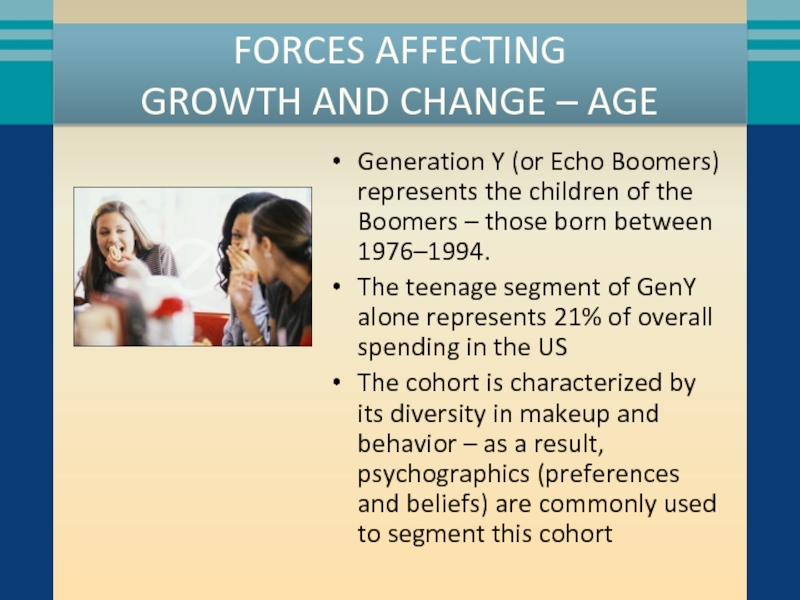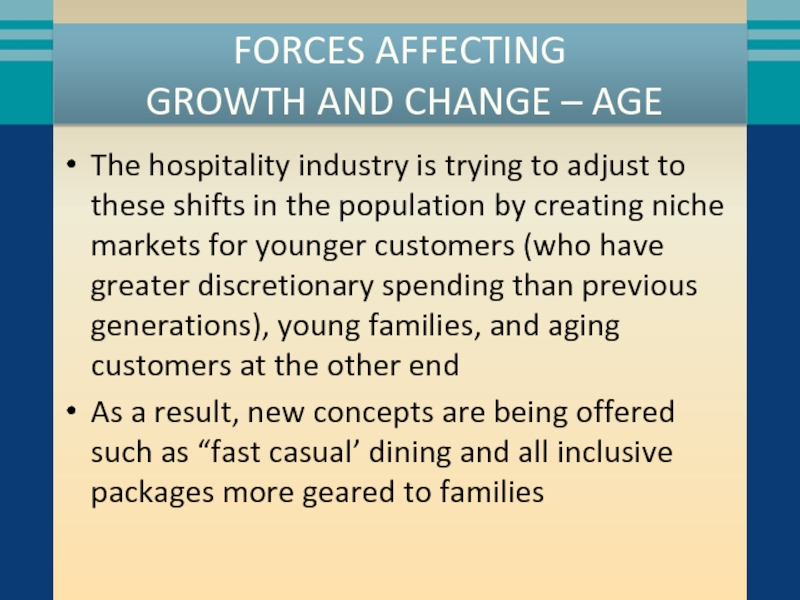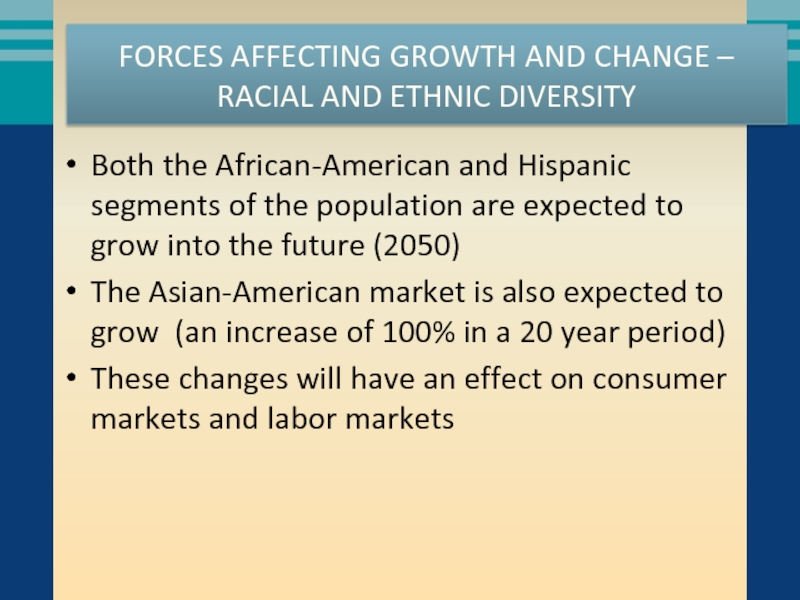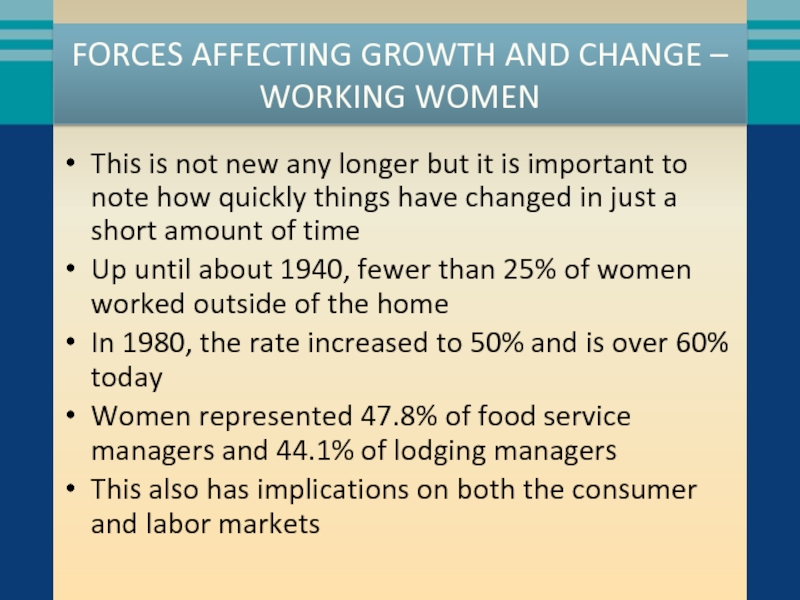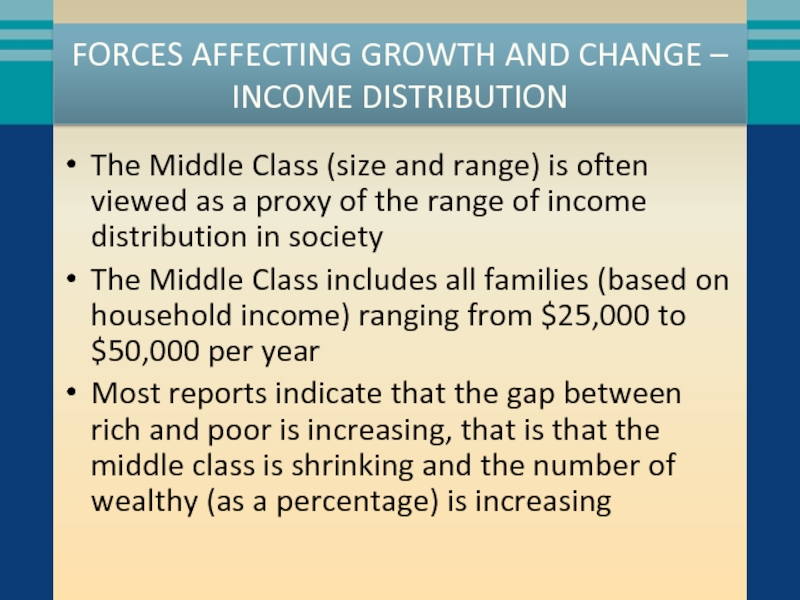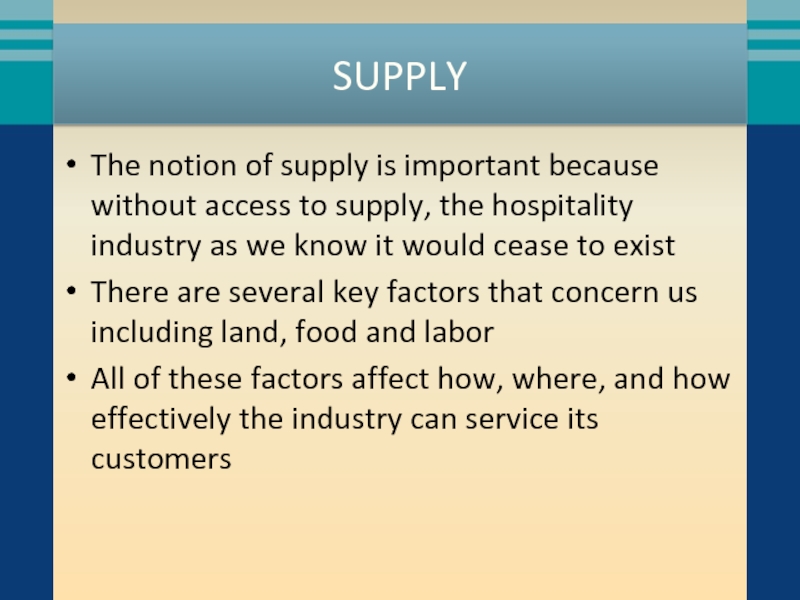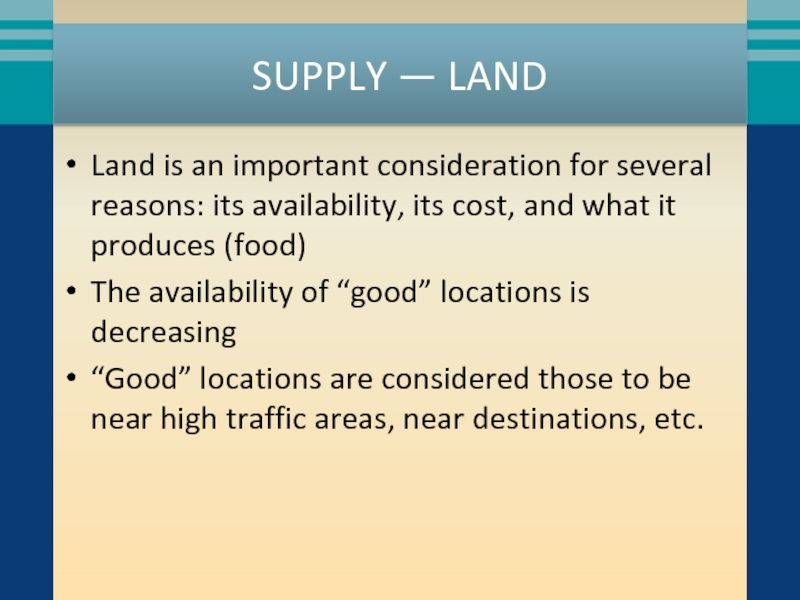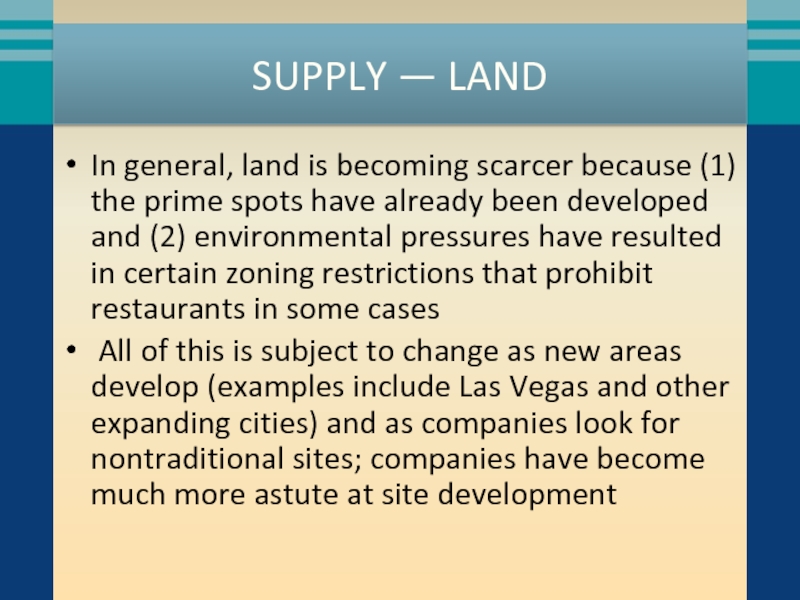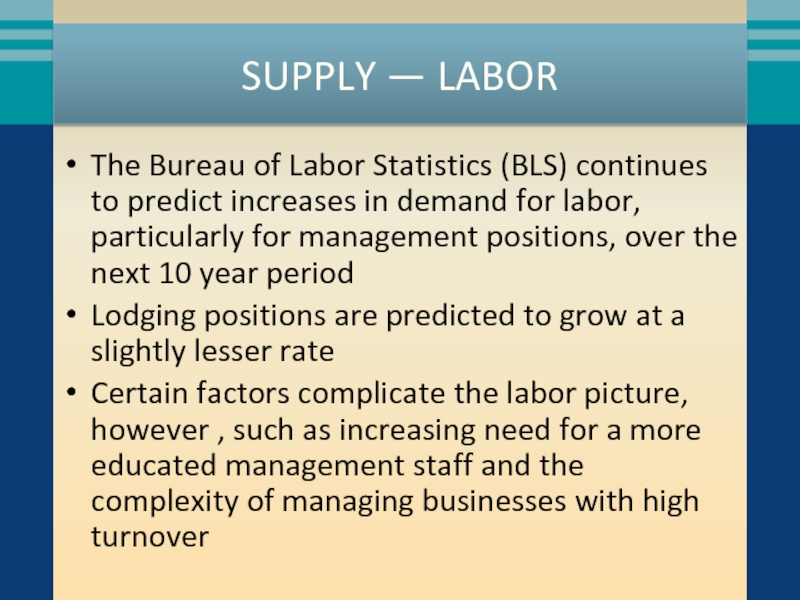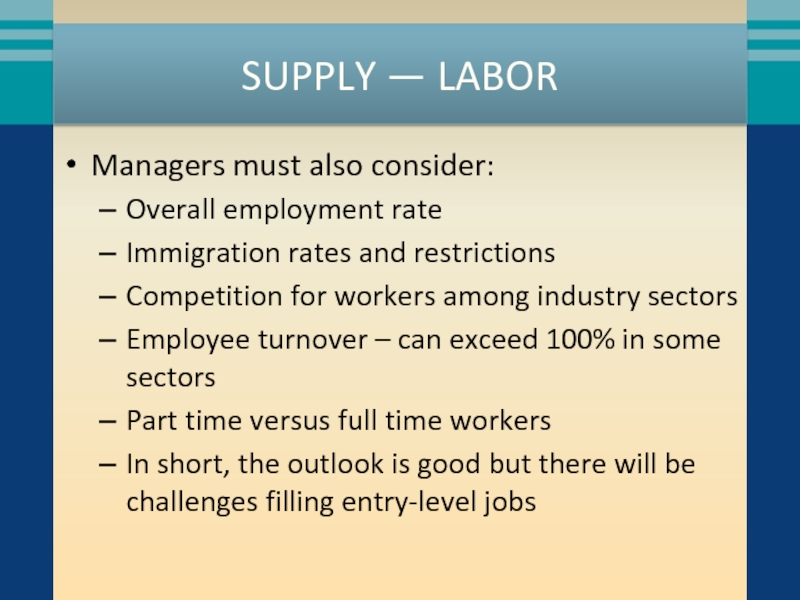2010 by John Wiley & Sons, Inc. All Rights Reserved
- Главная
- Разное
- Дизайн
- Бизнес и предпринимательство
- Аналитика
- Образование
- Развлечения
- Красота и здоровье
- Финансы
- Государство
- Путешествия
- Спорт
- Недвижимость
- Армия
- Графика
- Культурология
- Еда и кулинария
- Лингвистика
- Английский язык
- Астрономия
- Алгебра
- Биология
- География
- Детские презентации
- Информатика
- История
- Литература
- Маркетинг
- Математика
- Медицина
- Менеджмент
- Музыка
- МХК
- Немецкий язык
- ОБЖ
- Обществознание
- Окружающий мир
- Педагогика
- Русский язык
- Технология
- Физика
- Философия
- Химия
- Шаблоны, картинки для презентаций
- Экология
- Экономика
- Юриспруденция
Forces affecting growth and change in the hospitality industry презентация
Содержание
- 1. Forces affecting growth and change in the hospitality industry
- 2. FORCES AFFECTING GROWTH AND CHANGE The changes
- 3. FORCES AFFECTING GROWTH AND CHANGE —
- 4. FORCES AFFECTING GROWTH AND CHANGE – AGE
- 5. FORCES AFFECTING GROWTH AND CHANGE – AGE
- 6. FORCES AFFECTING GROWTH AND CHANGE – AGE
- 7. FORCES AFFECTING GROWTH AND CHANGE – AGE
- 8. FORCES AFFECTING GROWTH AND CHANGE –
- 9. FORCES AFFECTING GROWTH AND CHANGE – RACIAL
- 10. FORCES AFFECTING GROWTH AND CHANGE – WORKING
- 11. FORCES AFFECTING GROWTH AND CHANGE – INCOME
- 12. SUPPLY The notion of supply is important
- 13. SUPPLY — LAND Land is an important
- 14. SUPPLY — LAND In general, land is
- 15. SUPPLY — FOOD Food supply concerns have
- 16. SUPPLY — LABOR The Bureau of Labor
- 17. SUPPLY — LABOR Managers must also consider:
Слайд 2FORCES AFFECTING
GROWTH AND CHANGE
The changes that are occurring now in the
business environment are tremendous
Managers must understand the various forces that are driving these changes and affecting their businesses in order to be effective
A few of the changes that have impacted the industry just in recent years include terrorist attacks, problems with the supply chain, recession, and disease
On the whole, the hospitality industry has responded effectively but some segments, companies and destinations have suffered
Managers must understand the various forces that are driving these changes and affecting their businesses in order to be effective
A few of the changes that have impacted the industry just in recent years include terrorist attacks, problems with the supply chain, recession, and disease
On the whole, the hospitality industry has responded effectively but some segments, companies and destinations have suffered
Слайд 3FORCES AFFECTING GROWTH AND
CHANGE — DEMAND
Many of the changes that
are occurring are affecting demand for hospitality services
One of the major factors that is affecting demand is the changing population
To understand these changes, it is important to understand the concept of demographics
Demographics is the study of objectively measurable characteristics of the population
Examples include age, income, level of education, and sex, etc.
One of the major factors that is affecting demand is the changing population
To understand these changes, it is important to understand the concept of demographics
Demographics is the study of objectively measurable characteristics of the population
Examples include age, income, level of education, and sex, etc.
Слайд 4FORCES AFFECTING
GROWTH AND CHANGE – AGE
We often hear that “The population
is aging” but what does this mean?
While it certainly means that each of us is getting older, it also suggests that the oldest segments of the population, as a percentage, are increasing in size
While it certainly means that each of us is getting older, it also suggests that the oldest segments of the population, as a percentage, are increasing in size
Слайд 5FORCES AFFECTING
GROWTH AND CHANGE – AGE
One way that we can better
understand demographics is by segmenting the population – in this case by age
Baby Boomers were born between 1946 and 1964
Boomers represent 26 % of the population and are in their “high income” years, driving much of the economy
Boomers represent a large share of overall spending on foodservice, lodging travel, and recreation
Baby Boomers were born between 1946 and 1964
Boomers represent 26 % of the population and are in their “high income” years, driving much of the economy
Boomers represent a large share of overall spending on foodservice, lodging travel, and recreation
Слайд 6FORCES AFFECTING
GROWTH AND CHANGE – AGE
Generation X (or GenXers) were born
between 1965 and 1975
Even though they have received a lot of attention of late, they only represent about 14% of the population
They are different than Boomers and, perhaps, the first generation to have technological savvy – also the most educated
Even though they have received a lot of attention of late, they only represent about 14% of the population
They are different than Boomers and, perhaps, the first generation to have technological savvy – also the most educated
Слайд 7FORCES AFFECTING
GROWTH AND CHANGE – AGE
Generation Y (or Echo Boomers) represents
the children of the Boomers – those born between 1976–1994.
The teenage segment of GenY alone represents 21% of overall spending in the US
The cohort is characterized by its diversity in makeup and behavior – as a result, psychographics (preferences and beliefs) are commonly used to segment this cohort
The teenage segment of GenY alone represents 21% of overall spending in the US
The cohort is characterized by its diversity in makeup and behavior – as a result, psychographics (preferences and beliefs) are commonly used to segment this cohort
Слайд 8FORCES AFFECTING
GROWTH AND CHANGE – AGE
The hospitality industry is trying
to adjust to these shifts in the population by creating niche markets for younger customers (who have greater discretionary spending than previous generations), young families, and aging customers at the other end
As a result, new concepts are being offered such as “fast casual’ dining and all inclusive packages more geared to families
As a result, new concepts are being offered such as “fast casual’ dining and all inclusive packages more geared to families
Слайд 9FORCES AFFECTING GROWTH AND CHANGE – RACIAL AND ETHNIC DIVERSITY
Both the
African-American and Hispanic segments of the population are expected to grow into the future (2050)
The Asian-American market is also expected to grow (an increase of 100% in a 20 year period)
These changes will have an effect on consumer markets and labor markets
The Asian-American market is also expected to grow (an increase of 100% in a 20 year period)
These changes will have an effect on consumer markets and labor markets
Слайд 10FORCES AFFECTING GROWTH AND CHANGE – WORKING WOMEN
This is not new
any longer but it is important to note how quickly things have changed in just a short amount of time
Up until about 1940, fewer than 25% of women worked outside of the home
In 1980, the rate increased to 50% and is over 60% today
Women represented 47.8% of food service managers and 44.1% of lodging managers
This also has implications on both the consumer and labor markets
Up until about 1940, fewer than 25% of women worked outside of the home
In 1980, the rate increased to 50% and is over 60% today
Women represented 47.8% of food service managers and 44.1% of lodging managers
This also has implications on both the consumer and labor markets
Слайд 11FORCES AFFECTING GROWTH AND CHANGE – INCOME DISTRIBUTION
The Middle Class (size
and range) is often viewed as a proxy of the range of income distribution in society
The Middle Class includes all families (based on household income) ranging from $25,000 to $50,000 per year
Most reports indicate that the gap between rich and poor is increasing, that is that the middle class is shrinking and the number of wealthy (as a percentage) is increasing
The Middle Class includes all families (based on household income) ranging from $25,000 to $50,000 per year
Most reports indicate that the gap between rich and poor is increasing, that is that the middle class is shrinking and the number of wealthy (as a percentage) is increasing
Слайд 12SUPPLY
The notion of supply is important because without access to supply,
the hospitality industry as we know it would cease to exist
There are several key factors that concern us including land, food and labor
All of these factors affect how, where, and how effectively the industry can service its customers
There are several key factors that concern us including land, food and labor
All of these factors affect how, where, and how effectively the industry can service its customers
Слайд 13SUPPLY — LAND
Land is an important consideration for several reasons: its
availability, its cost, and what it produces (food)
The availability of “good” locations is decreasing
“Good” locations are considered those to be near high traffic areas, near destinations, etc.
The availability of “good” locations is decreasing
“Good” locations are considered those to be near high traffic areas, near destinations, etc.
Слайд 14SUPPLY — LAND
In general, land is becoming scarcer because (1) the
prime spots have already been developed and (2) environmental pressures have resulted in certain zoning restrictions that prohibit restaurants in some cases
All of this is subject to change as new areas develop (examples include Las Vegas and other expanding cities) and as companies look for nontraditional sites; companies have become much more astute at site development
All of this is subject to change as new areas develop (examples include Las Vegas and other expanding cities) and as companies look for nontraditional sites; companies have become much more astute at site development
Слайд 15SUPPLY — FOOD
Food supply concerns have always been present but they
are of a different sort now and, more sever in some cases. Operators must consider:
Seasonality
Effect of weather
Overfishing
Other effects such as bird flu
Seasonality
Effect of weather
Overfishing
Other effects such as bird flu
Слайд 16SUPPLY — LABOR
The Bureau of Labor Statistics (BLS) continues to predict
increases in demand for labor, particularly for management positions, over the next 10 year period
Lodging positions are predicted to grow at a slightly lesser rate
Certain factors complicate the labor picture, however , such as increasing need for a more educated management staff and the complexity of managing businesses with high turnover
Lodging positions are predicted to grow at a slightly lesser rate
Certain factors complicate the labor picture, however , such as increasing need for a more educated management staff and the complexity of managing businesses with high turnover
Слайд 17SUPPLY — LABOR
Managers must also consider:
Overall employment rate
Immigration rates and restrictions
Competition
for workers among industry sectors
Employee turnover – can exceed 100% in some sectors
Part time versus full time workers
In short, the outlook is good but there will be challenges filling entry-level jobs
Employee turnover – can exceed 100% in some sectors
Part time versus full time workers
In short, the outlook is good but there will be challenges filling entry-level jobs
